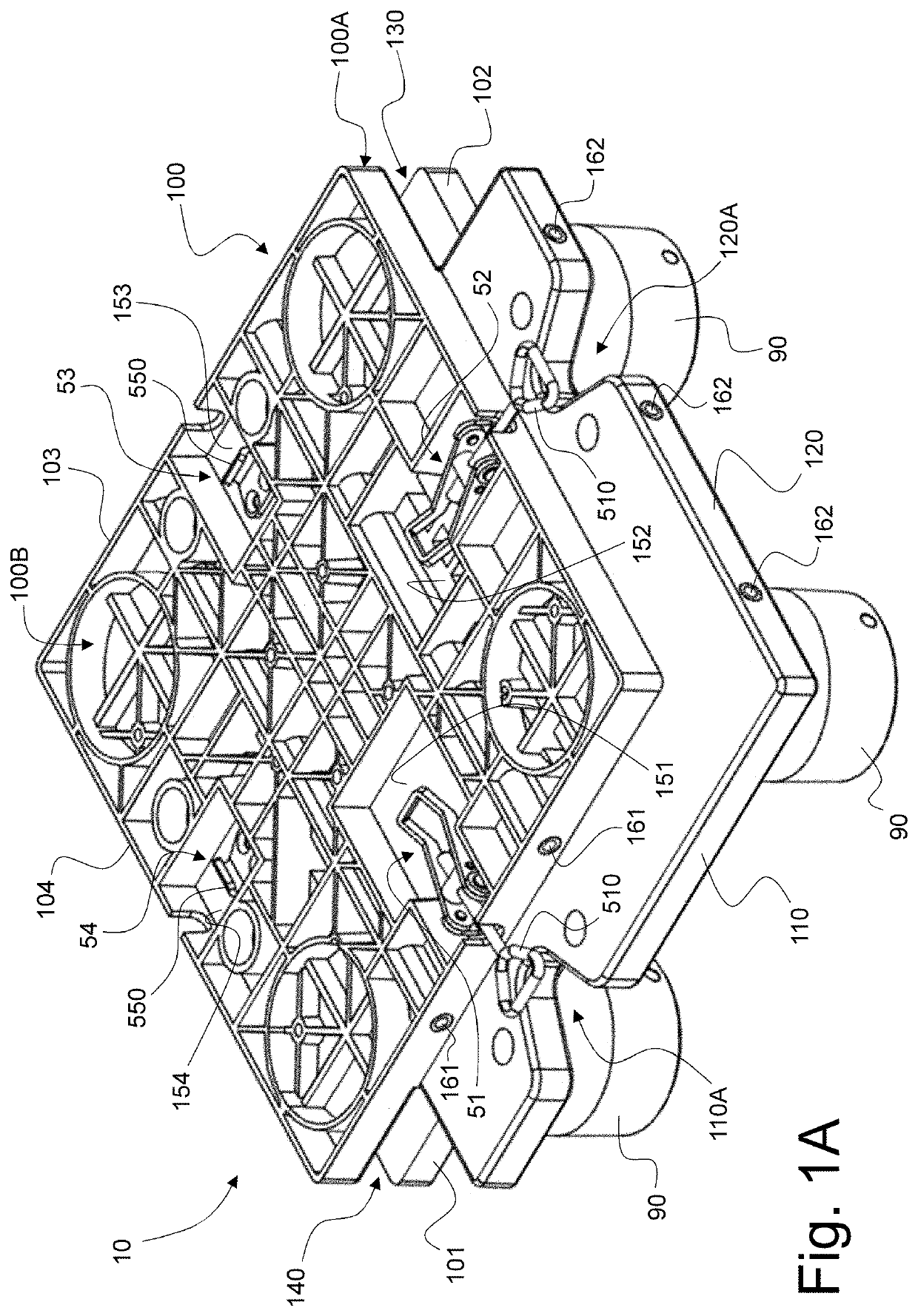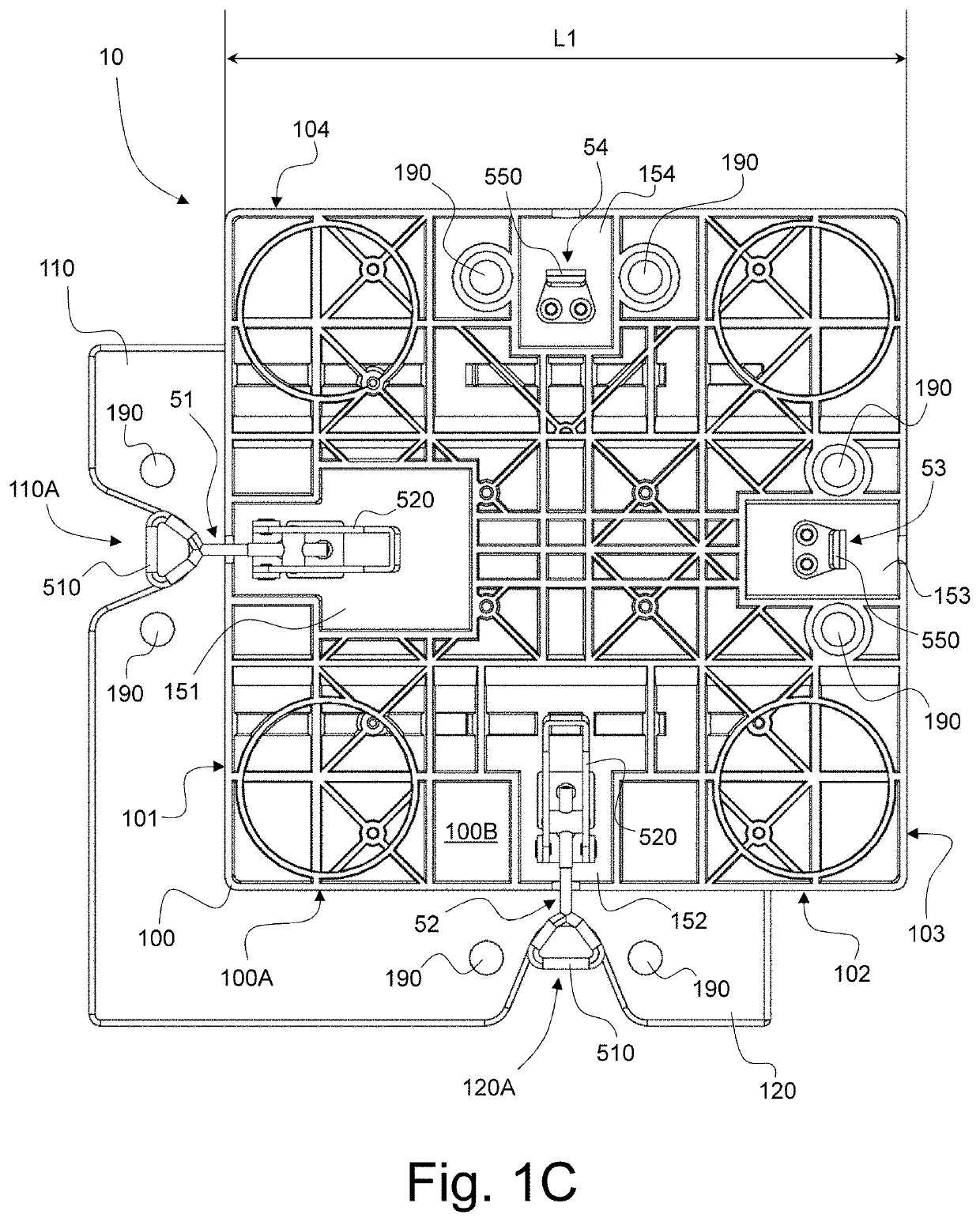Pallet module, assortment of pallet modules, and pallet assembly built of the same
a pallet module and pallet technology, applied in the field of pallet modules, can solve the problems of selective manual release of the foot element, prone to breakage, and potential disconnection of the pallet module, and achieve the effects of boosting efficiency and ease of use, facilitating assembly (and disassembling) very easily and quickly, and ensuring stability
- Summary
- Abstract
- Description
- Claims
- Application Information
AI Technical Summary
Benefits of technology
Problems solved by technology
Method used
Image
Examples
first embodiment
[0088]FIGS. 1A and 1B are two perspective views, taken from different viewing angles, of a pallet module, designated globally by reference numeral 10, in accordance with the invention. The same pallet module 10 is shown from the top and bottom in FIGS. 1C and 1D and from all four sides in FIGS. 1E to 1H.
[0089]The pallet module 10 (as well as the other embodiments of pallet modules described herein) is configured to allow formation of a nested pallet assembly of at least two similar pallet modules, be it another identical pallet module 10 or e.g. a compatible pallet module 20 or 30 as for instance shown in FIGS. 3A-C or FIGS. 4A-C.
[0090]The pallet module 10 comprises a main structural body 100 exhibiting a generally quadrilateral peripheral border 100A with first to fourth lateral sides 101-104 extending between upper and lower sides 100B, 100C of the main structural body 100. The first to fourth lateral sides 101-104 are here numbered in sequence in the counter-clockwise direction w...
second embodiment
[0114]FIGS. 3A-C are two perspective views, taken from different viewing angles, and a top view of a pallet module, designated globally by reference numeral 20, in accordance with the invention, and which forms part of a same assortment of pallet modules as the pallet module 10 of FIGS. 1A-H. The pallet module 20 will also be referred as a “large-size pallet module”.
third embodiment
[0115]FIGS. 4A and 4B are two perspective views, taken from different viewing angles, and a top view of a pallet module, designated globally by reference numeral 30, in accordance with the invention, and which likewise forms part of a same assortment of pallet modules as the pallet module 10 of FIGS. 1A-H and the pallet module 20 of FIGS. 3A-C. The pallet module 30 will also be referred as a “medium-size pallet module”.
[0116]The pallet modules 20 and 30 share a substantial number of common features with the pallet module 10, including:[0117]a main structural body 200, resp. 300, exhibiting a generally quadrilateral peripheral border 200A, resp. 300A with first to fourth lateral sides 201-204, resp. 301-304, extending between upper and lower sides 200B, 200C, resp. 300B, 300C, of the main structural body 200, resp. 300;[0118]first and second lateral flanges 210, 220, resp. 310, 320, extending outwardly from the peripheral border 200A, resp. 300A, of the main structural body 200, resp...
PUM
 Login to View More
Login to View More Abstract
Description
Claims
Application Information
 Login to View More
Login to View More - R&D
- Intellectual Property
- Life Sciences
- Materials
- Tech Scout
- Unparalleled Data Quality
- Higher Quality Content
- 60% Fewer Hallucinations
Browse by: Latest US Patents, China's latest patents, Technical Efficacy Thesaurus, Application Domain, Technology Topic, Popular Technical Reports.
© 2025 PatSnap. All rights reserved.Legal|Privacy policy|Modern Slavery Act Transparency Statement|Sitemap|About US| Contact US: help@patsnap.com



